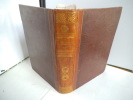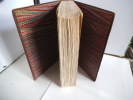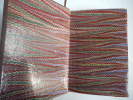-
Type
Art print (2)
Book (6501)
Magazine (21)
Manuscript (1)
Photographs (3)
-
Latest
Last 24h (2)
Last 3 days (6)
Last month (19)
Last week (3)
-
Language
English (10)
French (6514)
German (1)
Greek (1)
Latin (2)
-
Century
16th (3)
17th (11)
18th (256)
19th (929)
20th (3488)
21st (186)
-
Countries
Belgium (242)
Brazil (2)
Canada (3)
Côte d'Ivoire (11)
Denmark (1388)
France (4532)
Italy (38)
Switzerland (312)
-
Syndicate
ALAC (3)
CLAM (2)
ILAB (4302)
NVVA (149)
SLACES (149)
SLAM (2713)
SNCAO (15)
Das Relativitätsprinzip -- BEL EXEMPLAIRE RELIE
Braunschweig, Fridr. Vieweg, 1913, un volume in 8 relié en demi-chagrin marron (reliure de l'époque), 12pp., 272pp., figures dans le texte
---- Deuxième édition AUGMENTEE ---- Von Laue fut professeur à Munich, à Francfort sur le Main et enfin à Berlin ou il devient directeur de l'Institut de physique théorique. On lui doit diverses publications sur le principe de relativité et la découverte de la diffraction des rayons X par les cristaux. Ces expériences démontrèrent le caractère ondulatoire des rayons X et permirent de déterminer la structure des milieux cristallisés... En 1931, il donna une nouvelle forme de la théorie dynamique de la diffraction des rayons X par les cristaux**6611/M2
Servomechanism fondamentals
N.Y., McGraw-Hill, 1947, un volume in 8, cartonnage éditeur, 11pp., 277pp.
---- EDITION ORIGINALE, SECOND TIRAGE ---- BEL EXEMPLAIRE ---- Elementary forms of control systems - Servo system follow-up lines - Fundamentals of mechanics and electricity - Analysis of servomechanisms with viscous output damping - Analysis of servomechanisms with error-rate damping - Analysis of servomechanisms with combined viscous output damping and error-rate damping - Error-rate stabilization networks - Analysis of servomechanisms with integral control - Transfer function analysis of servomechanisms - Typical design calculations and general considerations**7384/M5DE
La théorie de la relativité. Traduction faite d'après la quatrième édition allemande revue et augmentée par l'auteur.
P., Gauthier-Villars, sans date (vers 1920-24), 2 tomes reliés en 1 volume demi percaline vert sapin, XVI-331 et XVI-318 pages ; cachets.
PHOTOS sur DEMANDE. ...................... Photos sur demande ..........................


Phone number : 04 77 32 63 69
La théorie de la relativité. Le principe de relativité de la transformation de Lorentz. La relativité générale et la théorie de la gravitation d'Einstein. Traduit par Gustave Létang sur la quatrième édition allemande revue et augmentée par l'auteur -- PREMIERE EDITION FRANCAISE -- 2 VOLUMES (COMPLETE SET) -- BEL EXEMPLAIRE
P., Gauthier-Villars, 1924/1926, 2 VOLUMES in 8, brochés, couvertures imprimées, T.1 : 16pp., 331pp., T.2 : 16pp., 318pp.
---- PREMIERE EDITION FRANCAISE ---- BEL EXEMPLAIRE ---- VON LAUE fut professeur à Munich, à Francfort sur le Main et enfin à Berlin ou il devient directeur de l'Institut de physique théorique. On lui doit diverses publications sur le principe de relativité et la découverte de la diffraction des rayons X par les cristaux. Ces expériences démontrèrent le caractère ondulatoire des rayons X et permirent de déterminer la structure des milieux cristallisés... En 1931, il donna une nouvelle forme de la théorie dynamique de la diffraction des rayons X par les cristaux"**6610/9100/M3-9101/cart.12
Au fond du labo à gauche - De la vraie science pour rire
Editions du Seuil , Science Ouverte Malicorne sur Sarthe, 72, Pays de la Loire, France 2004 Book condition, Etat : Très Bon broché, sous couverture imprimée éditeur crème, illustrée d'un dessin coloré d'un avion, un pingouin et un buste de femme In-8 1 vol. - 174 pages
1ere édition, 2004 Contents, Chapitres : Avant-propos, Texte, 174 pages bel exemplaire, intérieur frais et propre
Viande froide cornichons - Crimes et suicides à mourir de rire
Editions du Seuil , Science Ouverte Malicorne sur Sarthe, 72, Pays de la Loire, France 2006 Book condition, Etat : Très Bon broché, sous couverture imprimée éditeur crème, illustrée d'un dessin coloré d' une assiette composée d'un cornichon et d'une jambe coupée à la fouchette et à la tronçonneuse In-8 1 vol. - 164 pages
1ere édition, 2006 Contents, Chapitres : Avant-propos, Texte, 164 pages bel exemplaire, intérieur frais et propre
PROBLEMES DE PHYSIQUE ET DE CHIMIE, A L'USAGE DES CANDIDATS AUX CONCOURS D'ENTREE AUX ECOLES NORMALES ET AUX EXAMENS DU BREVET ELEMENTAIRE
Istra. Non daté. In-8. Relié. Etat d'usage, Couv. défraîchie, Dos frotté, Mouillures. 88 pages. Annotations (dessins) au crayon en pages de garde.. . . . Classification Dewey : 530-Physique
Livre de l'élève. Classification Dewey : 530-Physique
Physique et chimie
G. Delmas. 1890. In-12. Cartonné. Etat d'usage, Tâchée, Dos satisfaisant, Intérieur frais. 126 pp. Couverture et dos fortement noircis, coins légèrement frottés. Figures dans le texte.. . . . Classification Dewey : 530-Physique
Classification Dewey : 530-Physique
Sciences au temps ultracourts de l'attoseconde aux petawatts
Académie des sciences. s.d. In-4. En feuillets. Bon état, Couv. convenable, Dos satisfaisant, Intérieur frais. 8p dactylographiées. . . . Classification Dewey : 530-Physique
Classification Dewey : 530-Physique
physiognomonie
ou l’art de connaître les hommes d’après les traits de leur physionomie.Traduction nouvelle par H. BACHARAH. In 4 demi-cuir blond, dos lisse, titre, fers, filets, roulette, palmettes dorés. faux-titre, frontispice, titre, XVIII, 286 pages non rogné, texte sur 2 colonnes, très nombreuses illustrations (environ 500 physionomies) en 120 planches hors-texte gravées. Librairie Française et étrangère 1841. Charnière en grande partie renforcées. Bon état d’ensemble (Caillet 6236)
Threshold signals
Dover publications. 1950. In-8. Broché. Bon état, Couv. convenable, Dos satisfaisant, Intérieur frais. 388 pages augmentées de quelqus figures en noir et blanc dans texte.. . . . Classification Dewey : 530-Physique
Etiquette sur coiffe en pied. Tampon bibliothèque. texte écrit en anglais. Classification Dewey : 530-Physique
Cours de Physique à l'usage des Candidats à l'Ecole Spéciale Militaire de Saint-Cyr (2 Tomes - Complet) Tome 1 : Mécanique et Pesanteur - Chaleur - Généralités sur les Mouvements Vibratoires ; Tome 2 : Optique - Electricité
2 vol. in-8 reliure demi-basane rouge, dos à 5 nerfs, Librairie Classique Eugène Belin, Paris, 1938-1937, 331 et 325 pp.
Complet. Etat très satisfaisant (rel. un peu frottées, cachet de librairie sur une page de titre).
PHYSIQUE ET CHIMIE, CLASSE DE 4e B, 2e ANNEE DES EPS ET DES COURS COMPLEMENTAIRES
Hachette. Non daté. In-8. Relié. Etat d'usage, Couv. légèrement passée, Mors fendus, Intérieur bon état. 248 pages. Illustré de nombreux schémas en noir et blanc. Annotation en page de titre.. . . . Classification Dewey : 530-Physique
Programmes d'avril 1938. Classification Dewey : 530-Physique
PHYSIQUE ET CHIMIE, CLASSE DE 4e, COURS COMPLEMENTAIRES
Hachette. 1948. In-8. Relié. Bon état, Couv. convenable, Dos frotté, Intérieur bon état. 312 pages. Illustré de nombreux schémas en noir et blanc.. . . . Classification Dewey : 530-Physique
Programmes de juillet 1947. Classification Dewey : 530-Physique
PHYSIQUE ET CHIMIE, CLASSE DE 5e B, 1re ANNE DES EPS ET EDS COURS COMPLEMENTAIRES
Hachette. 1938. In-8. Relié. Bon état, Couv. légèrement passée, Dos satisfaisant, Intérieur bon état. 199 pages. Illustré de nombreux schémas en noir et blanc.. . . . Classification Dewey : 530-Physique
Programmes d'avril 1938. Classification Dewey : 530-Physique
COURS DE PHYSIQUE, CLASSE DE SCIENCES EXPERIMENTALES
Librairie Classique Eugène Belin. 1958. In-8. Broché. Bon état, Couv. légèrement passée, Dos satisfaisant, Intérieur bon état. 384 pages. Illustré de nombreux schémas en noir et blanc dans le texte.. . . . Classification Dewey : 530-Physique
Métrologie, mécanique, énergie. Phénomènes périodiques... Classification Dewey : 530-Physique
COURS DE PHYSIQUE, CLASSE DE 2de C ET MODERNE
Belin. 1952. In-8. Relié. Bon état, Couv. convenable, Dos satisfaisant, Intérieur acceptable. 333 pages. Illustré de nombreux schémas en noir et blanc dans le texte. 2e plat légèrement taché.. . . . Classification Dewey : 530-Physique
Enseignement du second degré, Programme 1945. Classification Dewey : 530-Physique
Lebedef (Pierre) - Piotr ou Pyotr Lebedev - T. Kousmine, traduction
Reference : 100610
(1926)
Pression de la lumière traduit du russe par T. Kousmine , dans la collection de Monographies Scientifiques Etrangères, dirigée par G. Juvet, n° IX (Pressure of Light)
Librairie Scientifique Albert Blanchard , Monographies Scientifiques Etrangères Malicorne sur Sarthe, 72, Pays de la Loire, France 1926 Book condition, Etat : Bon broché, sous couverture imprimée éditeur grise grand In-8 1 vol. - 71 pages
25 figures dans le texte (figures d'appareils et schémas) 1ere traduction en français, 1926 Contents, Chapitres : De la forme négative des corps rayonnants - Recherche expérimentale sur la pression de la lumière - Exposition des appareils et des expériences - Expériences - Résultats - Recherche expérimentale sur la pression de la lumière sur les gaz - Méthode de recherche - Appareils - Expériences préalables - Mesures - Calcul des valeurs absolues - Quelques notes bibliographiques - Piotr Nikolaïevitch Lebedev (Pierre Lebedef) (Moscou, 24 février 1866 - 1er mars 1912) est un physicien russe renommé. Lebedev a été le créateur de la première école scientifique en Russie. - Il obtient son doctorat à l'université de Strasbourg sous la supervision d'August Kundt en 1891. Cette même année, il commença à travailler au sein de l'université d'État de Moscou, dans le groupe d'Aleksandr Stoletov. C'est avec cette équipe de physiciens qu'il réalisa ses célèbres études expérimentales sur les ondes électromagnétiques. Il fut le premier à mesurer la pression de la lumière sur un corps solide, en 1899. Cette découverte fut annoncée au Congrès mondial de physique de Paris en 1900. Elle constitue la première confirmation quantitative de la théorie de Maxwell sur l'électromagnétisme. Piotr Lebedev obtient en 1901 le poste de professeur à l'université d'État de Moscou. En 1911, il abandonna cette fonction comme moyen de protester contre les politiques appliquées par le Ministère de l'Éducation. Cette même année, il reçut une autre offre qu'il refusa pour être professeur à Stockholm, en Suède. Il mourut l'année suivante. - Le premier à avancer un effet dynamique du rayonnement a été Johannes Kepler qui expliqua l'orientation des queues cométaires par le flux du rayonnement solaire (1619). Les efforts engendrés par une onde électromagnétique sur une paroi furent expliqués théoriquement par James Maxwell en 1873. Par la suite les efforts ont porté sur le lien entre approche électromagnétique et thermodynamique ou physique statistique. Les premières tentatives de mesure de pression par une approche thermodynamique sont dues à Adolfo Bartoli en 1884 et Pyotr Lebedev en 1900. Les expériences importantes ont été faites par Ernest Nichols et Gordon Hull qui ont montré le lien entre énergie et quantité de mouvement incident sur une surface en mesurant simultanément l'énergie par bolométrie et quantité de mouvement grâce à un radiomètre développé à cet effet (radiomètre de Nichols) en 1901 et 1903. (source : Wikipedia) bon exemplaire, quelques rousseurs discrètes sur le bord des plats de la couverture qui est sinon très propre, une note manuscrite dans le coin supérieur gauche, sans aucune gravité, intérieur sinon frais et propre, papier à peine jauni, cela reste un bon exemplaire, presque très bon
L'ARC ELECTRIQUE
LIBRAIRIE SCIENTIFIQUE ALBERT BLANCHARD. 1922. In-8. Cartonné. Bon état, Couv. convenable, Dos satisfaisant, Intérieur frais. 131 pages. Nombreux schémas en noir et blanc dans le texte.. . . . Classification Dewey : 530-Physique
Recueil des conférences-rapports de documentation sur la physique, volume 3, 1° série, conférences 7,8. Classification Dewey : 530-Physique
L'arc électrique Recueil des conférences-rapports de documentation sur la physique
Journal de physique. 1922. In-8. Relié. Bon état, Couv. convenable, Dos satisfaisant, Intérieur frais. 131 pages.. . . . Classification Dewey : 530-Physique
Etiquette sur coiffe en pied. Tampon bibliothèque. Classification Dewey : 530-Physique
LA TECHNIQUE DU VIDE
Armand Colin. 1951. In-16. Broché. Bon état, Couv. convenable, Dos satisfaisant, Non coupé. 187 pages. Illustré de nombreuses figures en noir et blanc dans le texte.. . . . Classification Dewey : 530-Physique
Collection Armand Colin, Physique, n° 266. Classification Dewey : 530-Physique
 Write to the booksellers
Write to the booksellers







